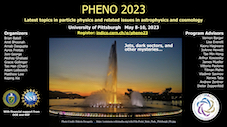Speaker
Description
We design a deep-learning algorithm for the discovery and identification of the continuous group of symmetries present in a labeled dataset. We use fully connected neural networks to model the symmetry transformations and the corresponding generators. We construct loss functions that ensure that the applied transformations are symmetries and that the corresponding set of generators forms a closed (sub)algebra. Our procedure is validated with several examples illustrating different types of conserved quantities preserved by a symmetry. In the process of deriving the full set of symmetries, we analyze the complete subgroup structure of the rotation groups SO(2), SO(3), and SO(4) and of the Lorentz group SO(1,3). Other examples include SO(10), squeeze mapping, and piece-wise discontinuous labels, demonstrating that our method is completely general, with many possible data science applications. In this talk, I will demonstrate finding the symmetries of the exceptional group G2 and the symmetries encoded in the MNIST digits.

